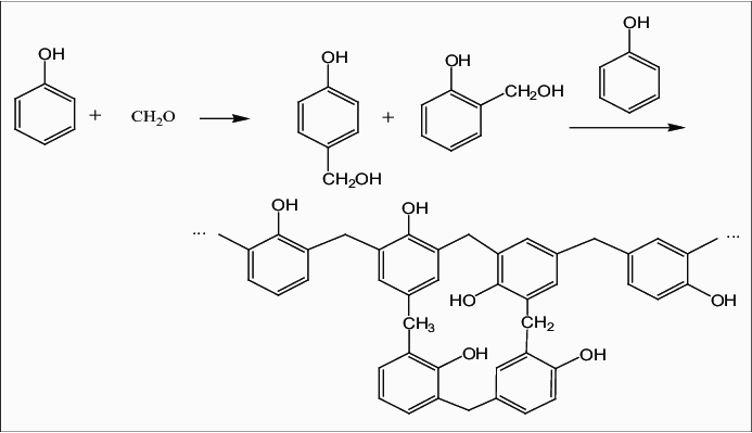
The monomer used in Novolac; a polymer used in paints is:
A. Butadiene and styrene
B. Phenol and formaldehyde
C. Butadiene and acrylo nitrile
D. Melamine and formaldehyde
Answer
140.4k+ views
Hint: There are different classes of polymers. Novolac is a phenolic resin type of polymer. It is extensively used in microelectronics.
Complete step by step answer: A polymer is a large molecule formed by continuous linking of many small subunits called Monomers. Basically, it is a repetition of monomers.
Another name for novolac is phenolic resin or phenol formaldehyde resin. As this suggests, the two monomers needed to form novolac are phenol and formaldehyde.
The reaction that occurs is –

The reaction stops when the formaldehyde reactant is exhausted, often leaving up to 10% of un-reacted phenol.
So, B is the correct option.
Additional information: There are two types of polymers, natural and artificial. Natural polymers are found in plants. Apart from natural and manmade, polymers are classified in various other ways.
Based on the type of monomer used and mechanism of polymerization, there are different types of polymers. Novolac is a cross linked polymer formed by condensation polymerisation. During preparation of novolac, as a general rule phenol gets substituted on both ortho and para positions. But we know that para position is almost twice as reactive as ortho. But there are twice as many ortho sites (two per phenol molecule) so the fractions of ortho-ortho, para-para and ortho-para bridges are approximately equal. In this reaction, a water molecule gets eliminated. Hence the type of polymerization mechanism is condensation. Distillation of the molten resin during manufacturing removes the excess phenol and water.
Note: To remember this easily, we can keep in mind that novolac is a phenolic resin type of polymer. It has a cross linked structure and is formed by condensation polymerization.
Complete step by step answer: A polymer is a large molecule formed by continuous linking of many small subunits called Monomers. Basically, it is a repetition of monomers.
Another name for novolac is phenolic resin or phenol formaldehyde resin. As this suggests, the two monomers needed to form novolac are phenol and formaldehyde.
The reaction that occurs is –

The reaction stops when the formaldehyde reactant is exhausted, often leaving up to 10% of un-reacted phenol.
So, B is the correct option.
Additional information: There are two types of polymers, natural and artificial. Natural polymers are found in plants. Apart from natural and manmade, polymers are classified in various other ways.
Based on the type of monomer used and mechanism of polymerization, there are different types of polymers. Novolac is a cross linked polymer formed by condensation polymerisation. During preparation of novolac, as a general rule phenol gets substituted on both ortho and para positions. But we know that para position is almost twice as reactive as ortho. But there are twice as many ortho sites (two per phenol molecule) so the fractions of ortho-ortho, para-para and ortho-para bridges are approximately equal. In this reaction, a water molecule gets eliminated. Hence the type of polymerization mechanism is condensation. Distillation of the molten resin during manufacturing removes the excess phenol and water.
Note: To remember this easily, we can keep in mind that novolac is a phenolic resin type of polymer. It has a cross linked structure and is formed by condensation polymerization.
Recently Updated Pages
Young's Double Slit Experiment Step by Step Derivation

Classification of Drugs Based on Pharmacological Effect, Drug Action

Difference Between Mutually Exclusive and Independent Events

Types of Solutions - Solution in Chemistry

Difference Between Circuit Switching and Packet Switching

Difference Between Mass and Weight

Trending doubts
JEE Main 2025 Session 2: Application Form (Out), Exam Dates (Released), Eligibility, & More

JEE Main 2025: Derivation of Equation of Trajectory in Physics

A point charge + 20mu C is at a distance 6cm directly class 12 physics JEE_Main

Fajans’ Rule

Logic Gate (AND, OR, XOR, NOT, NAND, NOR and XNOR)

JEE Main Exam Marking Scheme: Detailed Breakdown of Marks and Negative Marking

Other Pages
NCERT Solutions for Class 12 Chemistry Chapter 6 Haloalkanes and Haloarenes

NCERT Solutions for Class 12 Chemistry Chapter 2 Electrochemistry

NCERT Solutions for Class 12 Chemistry Chapter 7 Alcohol Phenol and Ether

NCERT Solutions for Class 12 Chemistry Chapter 1 Solutions

Solutions Class 12 Notes: CBSE Chemistry Chapter 1

Summary of The Poem A Photograph: CBSE Class 11 English (Hornbill)




